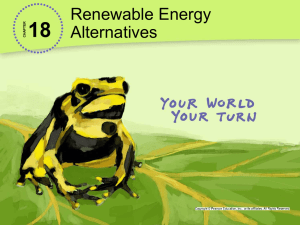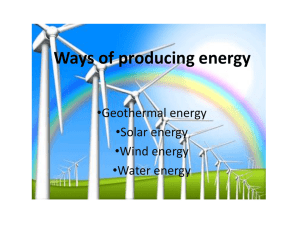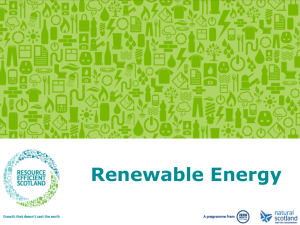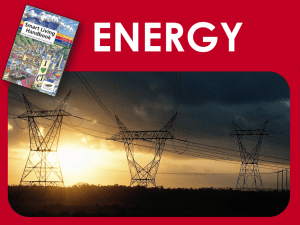Energy Source Fact Sheets
advertisement
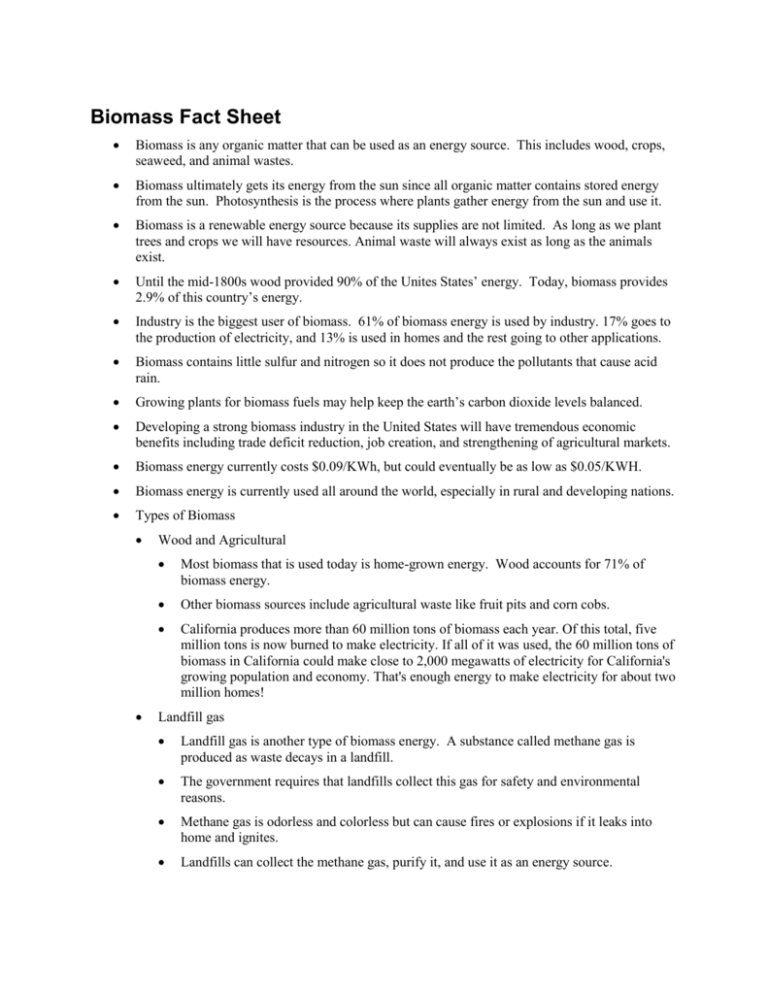
Biomass Fact Sheet Biomass is any organic matter that can be used as an energy source. This includes wood, crops, seaweed, and animal wastes. Biomass ultimately gets its energy from the sun since all organic matter contains stored energy from the sun. Photosynthesis is the process where plants gather energy from the sun and use it. Biomass is a renewable energy source because its supplies are not limited. As long as we plant trees and crops we will have resources. Animal waste will always exist as long as the animals exist. Until the mid-1800s wood provided 90% of the Unites States’ energy. Today, biomass provides 2.9% of this country’s energy. Industry is the biggest user of biomass. 61% of biomass energy is used by industry. 17% goes to the production of electricity, and 13% is used in homes and the rest going to other applications. Biomass contains little sulfur and nitrogen so it does not produce the pollutants that cause acid rain. Growing plants for biomass fuels may help keep the earth’s carbon dioxide levels balanced. Developing a strong biomass industry in the United States will have tremendous economic benefits including trade deficit reduction, job creation, and strengthening of agricultural markets. Biomass energy currently costs $0.09/KWh, but could eventually be as low as $0.05/KWH. Biomass energy is currently used all around the world, especially in rural and developing nations. Types of Biomass Wood and Agricultural Most biomass that is used today is home-grown energy. Wood accounts for 71% of biomass energy. Other biomass sources include agricultural waste like fruit pits and corn cobs. California produces more than 60 million tons of biomass each year. Of this total, five million tons is now burned to make electricity. If all of it was used, the 60 million tons of biomass in California could make close to 2,000 megawatts of electricity for California's growing population and economy. That's enough energy to make electricity for about two million homes! Landfill gas Landfill gas is another type of biomass energy. A substance called methane gas is produced as waste decays in a landfill. The government requires that landfills collect this gas for safety and environmental reasons. Methane gas is odorless and colorless but can cause fires or explosions if it leaks into home and ignites. Landfills can collect the methane gas, purify it, and use it as an energy source. One landfill in Alabama collects 32 million cubic feet of methane a day and pumps it into their natural gas pipelines. Methane is a more powerful greenhouse gas than carbon dioxide. It is better to burn landfill methane than to release it into the atmosphere. Anaerobic Digesters Methane is also produced when we chemically break down animal waste. Anaerobic digesters are airtight containers or pits lined with steel or bricks. Wastes that are placed in these containers are broken down by enzymes, the same way food is broken down in your stomach. Methane gas is produced that is then burned to make electricity. Anaerobic digesters are inexpensive to build and maintain and can be built for a family home or for a whole community. For developing countries, anaerobic digesters may be one of the best answers to many of their energy needs. Anaerobic digesters can help reverse the deforestation caused by wood burning and can reduce air pollution, fertilize over-used fields, and produce clean, safe energy for rural communities. How it works – Burning landfill or digester gas to make power Anaerobic Digester-Farm Size Engine-generator Information gathered from: The NEED Project Secondary Energy Infobook http://www.andgardigester.com http://www.nrel.gov/documents/biomass_energy.html http://www.darvill.clara.net/altenerg/biomass.htm http://www.eere.energy.gov/biomass/environmental.html http://www.eere.energy.gov/biomass/economic_growth.html Fossil Fuels Fact Sheet Coal, Oil and Gas are called "fossil fuels" because they have been formed from the fossilized remains of prehistoric plants and animals. Fossil fuels are a nonrenewable energy source since they take millions of years to form. Fossil fuels ultimately get their energy from the sun. The plants that turned into fossils stored energy from the sun by photosynthesis. 85.6% of all energy consumed in the U.S. comes from fossil fuels. The average U.S. Household pays about 8 1/2 cents per KWH and uses 10,000 KWH per year. Types of Fossil Fuels Coal Coal is the most abundant fossil fuel in the United States. Coal is a hard, black colored rock-like substance formed when dead plants were subjected to extreme heat and pressure for millions of years. It is made up of carbon, hydrogen, oxygen, nitrogen and varying amounts of sulfur. There are two ways to mine coal: Surface mining and underground mining Coal often costs more to transport than other fuels. Different types of coal have different amounts of carbon. The more carbon present, the more energy it contains. Coal deposits can be found in 38 states. Montana, Illinois, and Wyoming are the top coal states. Coal from the west has less sulfur content which means it produces fewer pollutants. The federal government owns a majority of the nation’s coal reserves. Coal generates 50.2% of the electricity used in this country. Coal industries are required to monitor the amount of pollutants they release into the air, and to reclaim land damaged by surface mining. Clean coal technologies that do not hurt the environment are currently being researched by scientists and engineers. Natural Gas Natural gas was formed from the remains of tiny sea animals and plants that died millions of years ago. The gas then became trapped in layers of rock like water in a wet sponge. Raw natural gas is a mixture of different gases. Its main ingredient is methane. The strange smell of natural gas (like rotten eggs) comes from a chemical natural gas companies add called mercaptan. This is added so leaks are easily detected. Natural gas was first used in America in 1816 to light the streets of Baltimore. Natural gas accounts for 23.7% of the energy in the U.S. Natural gas is found more than 6,000 ft. under the earth’s surface. Drilling can cost up to $100/ft so sites must be chosen carefully. Only 48% of the sites we drill actually produce natural gas. Natural gas is produced in 32 states. The top 3 are Texas, Oklahoma, and New Mexico. Natural gas is transported by pipeline. More than one millions miles of pipelines link natural gas fields to major cities in the U.S. Industry is the biggest consumer of natural gas, using it as a heating source and often as an ingredient in the products they produce. 60% of homes use natural gas for heating. Natural gas can be used in any vehicle with a regular internal combustion engine, although the vehicle must have a special carburetor and fuel tank. If we continue to use natural gas at the current rate, we will only have 30-50 years worth. Natural gas is the most environmentally friendly fossil fuel. Oil (Petroleum) Oil was formed from the remains of tiny sea animals and plants that died millions of years ago. The organic material was then broken down into hydrogen and carbon atoms and a sponge-like rock was formed, full of oil. Only 44% of wells that are drilled for oil actually produce it. The average oil well produces 11 barrels of oil per day. State and federal governments regulate oil drilling and production. Texas, Alaska, and California are the top three oil producing states. Oil cannot be used as it is when it is taken from the ground. Oil refineries clean and separate the oil into various fuels and by-products. The most important of these is gasoline. Gasoline and other petroleum products are transported through pipelines. There are about 230,000 miles of pipelines in the U.S. Petroleum supplies 37.2% of the energy used in the U.S. Americans use about 18 million barrels of oil every day. 67% of oil is used for transportation. The U.S. is becoming increasingly dependent on other countries for oil. We import about 2/3 of the oil that we consume in the U.S. from other countries. Some of these countries include: Iran, Russia, Mexico and, Canada. The biggest imports of crude oil to the U.S. come from Canada. The outer continental shelf (off the coasts of California and Alaska and in the Gulf of Mexico), contain rich deposits of petroleum and natural gas but offshore production is very costly. Petroleum production, distribution, and consumption can contribute to air and water pollution. Drilling for oil can disturb fragile ecosystems, especially when there is a spill. Leaking underground storage tanks pollute the groundwater and create toxic fumes. Even burning fuel in our cars emits pollutants. The Clean Air Act of 1970 helped us make advances in protecting our environment. Oil refineries had to reduce emissions and new technologies have been developed. This year the price of crude oil hit an all-time high of $66 per barrel. Companies that transport materials and products have been forced to increase their price just to keep up. How does it work? – Making power from fossil fuels Information gathered from: The NEED Project Secondary Energy Infobook http://www.energyquest.ca.gov/story/chapter08.html http://www.eere.energy.gov http://www.energy.gov http://www.tvakids.com/electricity/fossil.htm http://www.darvill.clara.net/altenerg/fossil.htm http://www.ecoworld.org/energy/EcoWorld_Energy_Resid_KWH_Prices.cfm A silly old man is a fossil fool. Geothermal Fact Sheet Geothermal energy comes from the heat within the earth. The word geothermal comes from the Greek words geo, meaning earth and therme, meaning heat. The outermost layer of the earth, the insulating crust, is broken into pieces called plates. These plates drift apart and push against each other in a process called plate tectonics. This process can cause the crust to become cracked or thinned, allowing plumes of magma to rise up into the crust. The magma can reach the surface (volcanoes) but most stays under the surface as geothermal heat. The underground heat can take 1000 to 1 million years to cool. In areas where there is underground water, the magma heats the water and creates either hot springs or underground reservoirs. Geothermal energy is renewable because water is replenished with rainfall and heat is continuously produced within the earth. Geothermal energy is harnessed by drilling wells into the underground geothermal reservoirs. The steam and heat is used to drive turbines in electric power plants. The water and steam from these reservoirs range in temperature from 250 to 700 degrees Fahrenheit. The hottest geothermal regions are found along major plate boundaries where earthquakes and volcanoes are concentrated. Most of the world’s geothermal activity occurs in an area known as the Ring of Fire, which rims the Pacific Ocean bounded by Indonesia, the Philippines, Japan, the Aleutian Islands, North, Central and South America. Geothermal energy accounts for 0.3% of the energy in the U.S. That is enough to provide power to 3 million households. It costs 4.5 to 7 cents per kWh to produce electricity from the average geothermal system. Geothermal steam and hot water contain naturally occurring traces of hydrogen sulfide and other gases that can be harmful in high concentrations. Sometimes these gases are extracted and used to make marketable products like liquid fertilizer. Geothermal plants release only 1% of the carbon dioxide emitted by comparable fossil fuel plants. The earth has no shortage of geothermal activity, but not all geothermal resources are easy or economical to use. Today there are geothermal power plants in 21 countries, providing electricity to 15 million people. There are four types of geothermal power plants. Flashed Steam Plants Most geothermal power plants are flashed steam plants. Hot water from production wells explosively boils, or flashes, into steam when it is released from the underground pressure of the reservoir. The force of that steam is then used to spin the turbine-generator. Dry Steam Plants The steam from the geothermal reservoir shoots directly through a rock-catcher into the turbine-generator. The rock-catcher protects the turbine from small rocks that may be carried along with the steam from the reservoir. The Geysers dry steam reservoir in California has been producing electricity since 1960 and produces enough electricity to supply a city the size of San Francisco. Binary Power Plants Binary power plants transfer heat from geothermal hot water to other liquids to produce electricity. Geothermal water is passed through a heat exchanger, which transfers the heat to a working fluid (isobutane or isopentane) which boils at a lower temperature than water. The vapor is then used to spin a turbine-generator. This way electricity can be produces from lower temperature reservoirs. Hybrid Power Plants Flash and binary systems are combined to use both the steam and the hot water from a reservoir. A hybrid system provides about 25% of the electricity to the big island of Hawaii. Water from geothermal reservoirs is used in many places to warm greenhouses that grow flowers, vegetables, and other crops. Heat from geothermal water is used worldwide for dying cloth, drying fruits and vegetables, washing wool, manufacturing paper, pasteurizing milk, and drying timber products. In Klamath Falls, Oregon, hot water is piped under sidewalks and roads to keep them from freezing in the winter. Geothermal Energy for heating and cooling The most widespread use of geothermal resources is to heat buildings. In the capital of Iceland, 95% of the buildings use geothermal heat. Geothermal systems at home Use the Earth’s constant temperatures to heat and cool buildings. These heat pumps transfer heat from the ground to buildings in the winter and vice versa in the summer. Geothermal systems cost more to install than conventional heating and cooling systems but they can reduce heating costs by 50-70%. Over the lifetime of the system, the average homeowner can anticipate saving about $20,000. Today more than 300,000 homes and building in the U.S use geothermal heat exchange systems The U.S. Environmental Protection Agency has rated geothermal heat pump systems among the most efficient heating and cooling technologies. The most important economic aspect of geothermal energy use is that it's homegrown — using geothermal energy reduces our dependence on foreign oil, creates jobs here in the U.S., and more favorably balances our global trading position. Information gathered from: The NEED Project Secondary Energy Infobook http://www.eere.energy.gov http://www.energy.gov http://www.ucsusa.org/clean_energy/renewable_energy http://www.darvill.clara.net/altenerg/geothermal.htm Hydropower Fact Sheet Hydropower is energy that comes from the force of moving water. Hydropower can be found anywhere water moves from high ground to low ground. The force of moving water can be extremely powerful. There are 3 major ways in which we can capture hydropower for our use: An impoundment facility uses a dam on a river to store water in a reservoir. Water is released from the reservoir through a turbine which activates a generator and produces electricity. A diversion facility channels a section of a river through a canal which also goes through a turbine generator in order to produce electricity. Micro-Hydroelectric Systems- Small turbine generators can be placed in a stream in order to generate electricity. A diversion facility at Idaho Falls. Hydropower plants cause no air pollution because they don’t burn fuel. However, damming rivers may disrupt wildlife and natural resources. Hydropower plants may also affect water quality by churning up dissolved metals that may have deposited in the water by industry long ago. Hydropower is the cheapest way to generate electricity today because, once a dam has been built and the equipment installed, the energy source (water) is free. This can help to reduce our dependence on foreign oil and strengthen our economy. The first hydroelectric plant was built at Niagara Falls in 1879. The top country using hydropower is Canada, generating around 325 billion kilowatt-hours per year. Other countries that use hydropower are the United States, Brazil, China, Russia, Norway, Japan, India, Sweden, and France. Today, hydroelectric power provides 2.7% of the energy used in the U.S. It costs about $0.01/KWh to produce electricity at a typical hydro plant. In general, hydropower is used to supply electricity to towns and cities through a power grid. People who have streams or waterfalls flowing on or near their property can use a microhydroelectric system to either power their house or sell back to the electric company Information gathered from: The NEED Project Secondary Energy Infobook http://www.DOE.gov (U.S. Department of Energy) http://hydropower.intel.gov (Idaho National Laboratory) www.energy.state.or.us (Oregon Department of Energy) Solar Energy Fact Sheet Solar energy is the light and heat provided by the sun. The energy comes from the center of the sun where hydrogen atoms combine to form helium in a process called nuclear “fusion” (in nuclear “fission” atoms split instead of combining). Solar energy can be found in many places. You can find solar energy provided as heat in the hot seat belt when you return to a parked car in a sunny parking lot. A plant uses the solar energy provided as light during photosynthesis. We use the solar energy provided as heat to warm our water and homes. We use the solar energy provided as light by turning it into electricity. There are 3 major ways in which we can capture solar energy for our use: Photovoltaic- A solar cell collects the light from the sun. The light may be reflected, absorbed, or may pass through the cell. Some of the energy absorbed can move electrons in the solar cell material which creates electricity. Solar cells are connected together to create solar panels. Photovoltaic Solar Panels Concentrating Solar Power Technologies- Curved reflectors are used to direct the sun’s energy to a single point in a tower. The heat produced at this point is used to heat a fluid. The steam produced turns a turbine which produces electricity. Hundreds of curved reflectors focus the sun’s energy to a central tower. Solar Heating can be as simple as using a window facing the sun to heat your bedroom. Solar collectors can be used to heat hot water pipes. Solar energy is one of the cleanest forms of energy as it produces no air or water pollution. However, the manufacturing and disposing of solar cells produces some waste products. The Solar cell industry can help to reduce our trade deficit and create new jobs which will strengthen the U.S. economy. Solar energy can protect the economy by keeping businesses open during power outages. Solar energy has been in use since 212 B.C. when the Greeks used mirrors to reflect the sun’s energy to light torches. The first Solar cells were invented in United States in 1883. They are now used in the U.S, Japan, France, Great Britain, parts of Africa, Antarctica, and even outer space. Today, solar energy in the form of electricity provides 0.1% of the energy used in the U.S. In general, solar energy costs about $0.30/KWh, but the world’s largest solar dish is capable of producing energy at $0.05/KWh. Today, solar energy is used to provide heating and electricity for homes and businesses. In the last decade, solar energy has also been used to power earth-orbiting satellites, cars, and even planes. The Helios prototype flying wing is shown near the Hawaiian Islands during its first test flight on solar power. (Credit: NASA, Dryden Flight Research Center Photo Collection) Information gathered from: The NEED Project Secondary Energy Infobook http://www.DOE.gov (U.S. Department of Energy) http://pubs.acs.org/subscribe/journals/esthag-w/2003/dec/tech/kb_energy.html (Energy Science and Technology online news) The foolish gardener planted a light bulb and thought he would get a power plant. Wind Power Fact Sheet: a. Wind power is a source of solar energy b. It is caused by the uneven heating, terrain, and bodies of water of the earth. c. Wind power is used for grinding grain, pumping water, or generating electricity. d. Historically windmills were used for propelling boats across the Nile, pumping water, and producing food. e. Wind Power is a renewable source because the source (wind) can never be fully used up. See Figure 2 f. Wind starts in the kinetic form and is converted to the mechanical energy form (grinding grain, pumping water, etc…), or to the electromagnetic form (electricity). g. Countries such as Denmark and Northern Germany generates up to 20% of their electricity through wind power. h. India and many European countries are planning for major wind facilities. i. There are 3 sizes/types of wind turbines: small (residential), medium (average size homes), and large (commercial). j. Wind energy does not have any output pollutants which makes it a very favorable means of electricity. k. Some concerns of wind turbines are their blades because they can kill some birds as they turn. l. They are also seen as a visual and auditory nuisance. m. Wind Turbines are the mechanism used to harness the wind energy. n. Wind power plants or Wind Farms are a collection of many wind turbines to generator energy. o. These winds farms are usually not public utility companies; rather they are private corporations that sell the electricity produced. p. Wind farms require a lot of land; each turbine needs approximately 2 acres. q. The good part about wind farms is that crops can be grown around the mechanisms as soon as the installation is complete. r. There are 2 types of wind turbines: the traditional horizontal-axis turbine with the blades and the vertical-axis turbine called the Darrieus Design. See Figure 5 s. The most common type used today is the horizontal-axis turbine because it is more stable at greater heights where the wind is more turbulent. See Figure 4 t. Wind turbines are made up of a rotor, which includes the blades and the hubs they are attached to, a nacelle, which is the frame for the gearbox and generator, and a tower; this is usually a large steel tubular structure. See figure 1. u. The blades of the wind turbines are very often made of fiberglass or other high-strength materials. v. The gears inside the turbine are important because they allow the turbine to turn slowly while the electric motor turns extremely quickly. Commercial-scale Turbine: 3 blades Tubular tower Hub height 164-262 ft Diameter 154-262 ft Power ratings in U.S. 660 KW-1.8 MW Residential-scale Turbine (30kW and below) 3 blades Hub Height 18-37 m Diameter 1-13 ~21,000 kW/year w. The best places for wind production in the U.S. include California, Alaska, Hawaii, the Great Plains, and mountainous regions. x. It is thought that there is enough wind in 37 states to produce electricity. y. Average wind speed of 14 mph must be kept for wind energy to be converted to electricity economically. z. The average wind speed in the U.S. is 20 mph. aa. Anemometers are used to measure how fast the wind is blowing at a particular site. bb. Wind energy converts 30-40% of the wind’s kinetic energy into electricity. cc. The cost of electricity by wind power is ~5 cents per kWh. dd. For a Grid Internie System in which the wind turbines energy can make up for the grid electricity, the general cost of a turbine is ~$40,000. ee. The turbines themselves cost ~$25000. This is for a home system and not for a commercial sized wind turbine. Fig. 1 The components of a common horizontal-axis turbine Fig.2 Traditional Windmill Fig. 3 Horizontal-axis turbines Fig. 4 Vertical-axis turbine (Darrieus design) Information compiled from: 1. The NEED Project Secondary Energy Infobook 2. Energy Efficiency and Renewable Energy http://www.eere.energy.gov/consumerinfo/ 3. Department of Energy http://www.doe.gov 4. National Renewable Energy Laboratory 5. http://www.nrel.gov/ 6. EERE, “How Turbines Work,” http://www.eere.energy.gov/windandhydro/wind_how.html, August 2005. 7. Eggleston, Eric. “What are Vertical-Axis Wind Turbines?”, http://www.awea.org/faq/vawt.html, August 2005 8. “Wind Energy Systems” http://www.energy.iastate.edu/renewable/wind/wem/wem-07_systems.html, August 2005. 9. EERE,“Sizing Your Wind System”, http://www.eere.energy.gov/consumerinfo/makeelectricity/eval_wintrb_size.html, August 2005. 10. Renewable Energy Research Laboratory, http://www.ceere.org/rerl/, August 2005. Wind Power is very popular because it has a lot of fans. Uranium Fact Sheet Uranium-238 has 238 protons and 238 neutrons in each atom. This type of uranium splits easily. When the atom splits, nuclear “fission” occurs and energy is produced (In nuclear “fusion”, atoms combine instead of splitting). Uranium can be found in rocks all over the world. Rocks that contain a lot of uranium are called uranium ore. There is a process in which we can create nuclear energy from uranium: o Mining- Workers mine uranium ore much like coal miners mine coal, in deep underground mines or in open pits. o Milling- The uranium ore is crushed and mixed with an acid. The uranium dissolves and forms a yellow powder called a “yellow cake”. o Conversion- The yellowcake is converted into the gas, uranium hexafluoride (UF6). o Enrichment- The UF6 gas contains a mix of different types of uranium. Some of the unwanted uranium is filtered out while the uranium-238 atoms are kept. After this is done, we have “enriched uranium”. o Fuel Fabrication- The enriched uranium is made into “fuel pellets”. A fuel pellet is about the size of your fingertip but can produce as much energy as 120 gallons of oil. The fuel pellets are sealed in 12-foot metal tubes called “fuel rods”. o Nuclear Reactor- The fuel rods are hit with neutrons, causing a nuclear reaction. The nuclear reaction produces heat which boils water. The steam from the boiling water is used to turn a turbine which produces electricity. Nuclear power plants produce radioactive waste. The amount of waste produced is much less than fossil fuel waste, but it is far more dangerous. If the power plant isn’t safe and the radioactive waste leaks, serious illness and death can occur. However, if the power plant is safe, there is very little impact on the environment. There is no air pollution, and the waste is recycled. The cost of uranium is cheap, but the power plants are expensive to build. Uranium is still an abundant natural resource and could provide us energy for many years – estimates range from 50 years to 500 years at current consumption rates. If we convert the uranium into plutonium (an even better fuel), we could have enough energy for millions of years. There are plenty of uranium mines in the United States. This can help to reduce our trade deficit and create new jobs which will strengthen the U.S. economy. Nuclear power plants can be found in the United States, France, Japan, and Germany. France generates 75% of its electricity with nuclear power. Today, energy produced from uranium provides 8.3% of the energy used in the U.S. Nuclear energy costs about $0.02/KWh. Today, there are 65 nuclear power plants in the United States. No new power plants are planned in the U.S because of safety concerns and building costs. World's First Large-Scale Nuclear Power Plant in Shippingport, Pennsylvania Information gathered from: The NEED Project Secondary Energy Infobook http://www.DOE.gov (U.S. Department of Energy) Q: What do nuclear physicists do on their spare time? A: They go fission.



